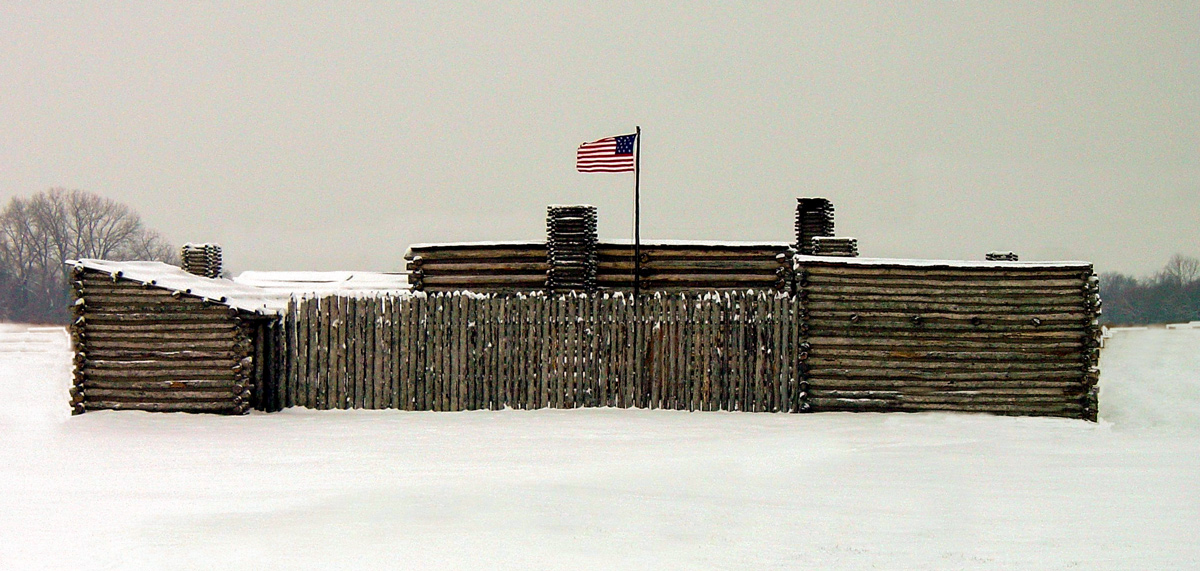On or near this snowy day at winter camp across from the mouth of the Missouri, Clark estimates that the expedition will cross the Rocky Mountains by 19 November 1804. Lewis continues working in Cahokia and St. Louis. In a letter to Lewis, President Thomas Jefferson discusses John Evans and the “Welsh” Indians.
A Snowy Day
Camp River Dubois
Photo provided by Lewis & Clark State Historic Site, Hartford, Illinois. Used by permission.
Snow all the last night, and Snows this morning, the debth is 5¾ Inches, The Thermometer Stands at 9 oClock this morning in the Open Air at 11° abov 0,—
—William Clark
Estimated Trip Times
[1804] [mls] [months] [days] 1[st] Winter{ From Mandens to the rock mountains is 12° W. at 41 mes. [to a degree of longitude]
Say 900 miles at 10 pr Day is 90 Days, Viz: Septr. Octr. Novr. & 4 Ds900 in 3 0 From Same at 12 miles pr Day 65 Days Septr. Octr & 19 of Novr 2 15 —William Clark, undated field note[1]This table has been created from Moulton, Journals, 2:159 and Ernest S. Osgood, The Field Notes of William Clark, 1803–1805, Document 7 (New Haven and London: Yale University Press, 1964), 19 and … Continue reading
Mr. Evans’ Map
Washington Jan. 22. 1804.
Dear Sir [Meriwether Lewis]
since the date of the last we have no certain information of your movements. with mine of Nov. 16. I sent you some extracts made by myself from the journal of an agent of the trading company of St. Louis up the Missouri. I now inclose a translation of that journal in full for your information. in that of the 13th inst. I inclosed you the map of a mr Evans, a Welshman, employed by the Spanish government for that purpose, but whose original object I believe had been to go in search of the Welsh Indians, said to be up the Missouri. on this subject a mr Rees of the same nation, established in the Western parts of Pensylvania, will write to you.
Th: Jefferson[2]Founders Online, National Archives, founders.archives.gov/documents/Jefferson/01-42-02-0285. [Original source: The Papers of Thomas Jefferson, vol. 42, 16 November 1803–10 March 1804, ed. James P. … Continue reading
Weather Diary
Therm. at rise
weather wind Therm. at 4 oClock weather wind River 11 above 0 Snow shfty. 13 above 0 snow N W fall Snow 5¾ In Deep Ice runing down the Missouri,
—Meriwether Lewis and William Clark[3]To assist the reader, the editor of this web page has omitted the date column, merged the “River” columns, and spelled out some abbreviations.
Experience the Lewis and Clark Trail
The Lewis and Clark Trail Experience—our sister site at lewisandclark.travel—connects the world to people and places on the Lewis and Clark Trail.
Plan a trip related to January 22, 1804:

Winter Camp at Wood River (Camp Dubois) is a High Potential Historic Site along the Lewis and Clark National Historic Trail managed by the U.S. National Park Service. The site, near Hartford, Illinois, is managed as Lewis and Clark State Historic Site and is open to the public.
Notes
| ↑1 | This table has been created from Moulton, Journals, 2:159 and Ernest S. Osgood, The Field Notes of William Clark, 1803–1805, Document 7 (New Haven and London: Yale University Press, 1964), 19 and 203. Table borders and shading have been added for clarity. |
|---|---|
| ↑2 | Founders Online, National Archives, founders.archives.gov/documents/Jefferson/01-42-02-0285. [Original source: The Papers of Thomas Jefferson, vol. 42, 16 November 1803–10 March 1804, ed. James P. McClure (Princeton: Princeton University Press, 2016), 325–326.]; also in Letters of the Lewis and Clark Expedition with Related Documents: 1783-1854, 2nd ed., ed. Donald Jackson (Urbana: University of Illinois Press, 1978), 165. |
| ↑3 | To assist the reader, the editor of this web page has omitted the date column, merged the “River” columns, and spelled out some abbreviations. |



